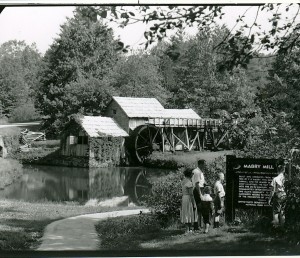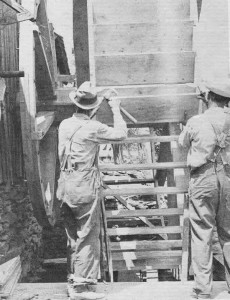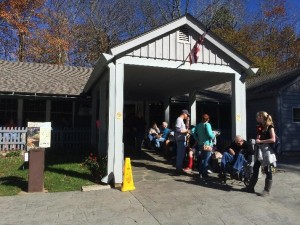Site Map of Mabry Mill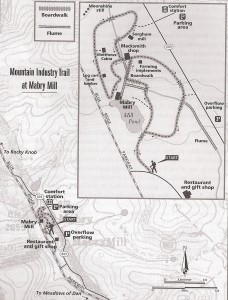
[Link to Street view of the Mabry Mill Site]
Timeline of major points or events in the site’s development.
- 1899: Edwin “Ed” Mabry and his wife, Elizabeth “Lizzie” Mabry, moved to the property and farmed the land for a couple of years, before Ed moved off of the property to work as a blacksmith.[1]
- 1903: Mabry returned to the property around 1903 and by 1908 had completed the gristmill.[1]
- 1908: gristmill construction completed[1][Link to Floor plan of Mabry Mill]
- 1910:The blacksmith shop construction completed[1][Link to Blacksmith Shop (Interior)]
- 1915: sawmill construction completed, Mabry’s house built using lumber from the mill.
- 1916: woodworking shop construction completed[1]
- 1936: Mabry died in 1936 and in 1938, Lizzie Mabry sold the property to the Virginia State Highway Commission.[2]
- 1938: Lizzie Mabry sold the property to the Virginia State Highway Commission.[2]
- 1942: the Mabry House as well as other dilapidated buildings on the property were razed to the ground; The NPS began restorations on the mill as well as the blacksmith shop
- 1944: they handed over the running of the mill to National Park Concessions, Inc.[1]
- 1956: A craft and coffee shop was built on the site; Matthews’ log cabin was erected on the property.
- 1957: a cane mill or sorghum press, a mint still, a lumber drying rack, and a bark mill from Rocky Knob were installed on the grounds as well.
- 1965: plans to remodel the Mabry Mill Restaurant fell through when plans to move the site to Rocky Knob were shot down by National Park Concessions, Inc.[6]
- 2014: NPS’s Restoration of the site announced
Physical description of the Mabry Mill site
Mabry Mill is a watermill located at milepost 176.2 of Blue Ridge Parkway in Floyd County, Virginia[2]. The approximate size of the site is roughly 1.5 acres[2]&[3]. The mill was constructed in 1903. Overall, the buildings are mostly constructed with wood frame structure on a stone foundation[2]. As far as we can tell, the property now stands at roughly one-half acre and holds the gristmill itself, a blacksmith and wheelwright shop, a log cabin, an elaborate flume system, and the Mabry Mill Restaurant.[5]
When the site was built, it consisted of a blacksmith shop, a chicken house, a granary, a wheelwright shop, a one room cabin, a bark mill, a sorghum mill, and an old time whiskey still. The gristmill/sawmill/woodworking shop has been restored.[4]
| The first photograph pre-restoration of Mabry Mill. The second photograph was taken during the restoration. The third photo provides the restoration image of Mabry Mill. The National Park Service restoration of the Mill was completed in 1942. This photo was taken in June of 1950. These photos provide a contrast between the privately own Mabry Mill and the Public NPS managed Mabry Mill. |
The mill is designed as a grain mill. The mill has no electricity and is powered by a water wheel fed by an elaborate viaduct system. The building itself is built with hand split logs and has stone foundation walls. The roof membrane and decking are hand split cedar shingles, giving the mill a rustic weathered appearance. The water flows down the millrace and the giant wheel makes creaking sounds as it turns causing the grinding stone inside the mill to be set in motion.[2]
Another attraction is the Mabry Mill restaurant, located 300ft south of Mabry Mill. The building is constructed on a concrete slab on grade with a standard wood frame structure. 90% of the roof membrane are concrete shingles with 10% asphalt shingles on the newer addition. The decking is 1×6 T+G supported by 2×10 16in o.c. The interior finishes vary from glazed tile to wood paneling and is in good condition. The restaurant also consist of a gift shop area.
Overall, the upkeep of the site was top-notch. The buildings distinctly more “aged” than the paths and wooden bridges that directed visitors around the site, but all of the more recent construction on the site (bridges, stone pathways) was done in a tasteful manner that complimented the “rural life” image of the site itself.
From Ed Mabry’s vision of the site to NPS’s vision of the site (Key story)
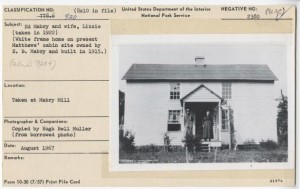
| The is the photograph of Ed Mabry and his wife, Lizzie, and their lovely home/cabin. He is the original owner of the land, user and builder of the Mabry Mill. The photo was taken in 1922, and was filed at August, 1967, by the NPS. |
Edwin “Ed” Mabry and his wife, Elizabeth “Lizzie” Mabry[Link to The original owners of the Mabry Mill] , moved to the property in 1899 and farmed the land for a couple of years, before Ed moved off of the property to work as a blacksmith. Mabry returned to the property around 1903 and by 1908 had completed the gristmill. The blacksmith shop, sawmill, and woodworking shop were added in 1910, 1915, and 1916 respectively. Around 1915, Mabry built a house on the property using lumber from the mill. Only fifteen years later, however, the gristmill had become obsolete and Mabry had to install two kerosene engines in order to keep the gristmill running[1]. Noted that Ed’s plan for the site consisted of a blacksmith shop, a chicken house, a granary, a wheelwright shop, a one room cabin[Link to Matthew’s cabin], a bark mill, a sorghum mill and an old time whiskey still, all of which serves for one purpose, which is to produce economic resources which they needed both to trade and to consume. For instance, the mill was used to produce grain and lumber; the blacksmith shop was used to produce tools they needed.
After NPS’s acquisition of the property, the National Park Service had to decide what to keep from the property[Link to Map of Area to be paved for Mabry mill site]. Under the guidance of the NPS, the site because valuable as way to articulate a narrative of mountain culture. Despite recommendations from Stanley Abbott, the Mabry House as well as other dilapidated buildings on the property were razed to the ground in 1942. In that same year, the National Park Service began restorations on the mill as well as the blacksmith shop[Link to Blacksmith Shop-Mabry Mill post acquisition]. A craft and coffee shop was built on the site in 1956, and shortly thereafter the Matthews’ log cabin was erected on the property[Link to Restoration of Mathews cabin]. In 1957, a cane mill or sorghum press, a mint still, a lumber drying rack, and a bark mill from Rocky Knob were installed on the grounds as well[Link to restoration of Mabry Mill]. Finally, in 1965, plans to remodel the Mabry Mill Restaurant fell through when plans to move the site to Rocky Knob were shot down by National Park Concessions, Inc.[1] Suggested by the equipment in the buildings, which illustrate the living in the early 20th century, and demonstrate old time skills like basket weaving, seat caneing, spinning, and weaving, NPS utilizes the site to interpret “Appalachian life” in the early twentieth century, demonstrating historic skills. The National Park Service operates a gift shop on the property as well., and in 1944, they handed over the running of the mill to National Park Concessions, Inc.
Current status of the site
The mabry mill is one of the most visited site in the Blue Ridge Parkway. Approximately 150-200 people at any given time were at the site. Working the site was Will Foster at the Blacksmith Shop, Noah Miller at the Mabry Mill, and Michael Ryan at the Mathews Cabin. All three were white men with approximate ages in the 50s to 60s range.
In the main and overflow parking lots, the overwhelming majority of cars boasted license plates from Virginia and North Carolina suggesting that at least some of those more “local” visitors were brought to the site by the pleasing weather conditions that day. There were other cars from as far away as Arizona as well as biker gang from British Columbia present.
In our site visit, we noticed that most visitors are engaged in photo-taking, casual strolls around the property and light conversation with park employees. There is also a hiking trail on the site for those who wanted to stretch their legs. There was some congestion around the blacksmith shop at points as well as the mill. The Mathews cabin was also an attraction but seem to have lighter attendance than the other buildings.
Site visit photo of Mabry Restaurant
The biggest attraction by far was the Restaurant and Craft Store as their was a 90 minute wait to be seated and always a sizable crowd outside, either waiting to be seated or eating ice cream from the ice cream shop located at the front of the building.
Future prospects & ongoing projects
The site remains one of the most visited attraction. Therefore, In 2014, More than $51,000 in work is set to be done at Mabry Mill in Meadows of Dan beginning soon after the site closes to visitors in October, Parkway Foundation Chief Executive Officer Carolyn Ward. The most visible part of the project will be the repair of the picturesque water wheel, which has been featured in countless photos, postcards and paintings of the parkway.[6]
Problems ahead- lack of funding
Other than the NPS restoration of 2014, another ongoing project organized by the Blue Ridge parkway foundation, the project seek to restore the Mabry Mill waterwheel and dredge the mabry mill pond. In recent years, the mill wheel had deteriorated and was in dire need of repair. Buckets on the wheel no longer held water and the wooden blocks that supported the wheel’s axle had deteriorated. The pond was choked with overgrown vegetation and silt. The Foundation committed $65,000 toward this project. And though the restoration project is complete, the Foundation still needs to raise approximately $40,000 to cover the costs of the project.[7]
[1]“Blue Ridge Parkway, HAER No. NC-42,” Historic American Engineering Record, 1997, 218-19.
[2] Mabry Mill Preliminary Layout, June 18, 1953.
[3] “Mabry Granary.” Blue Ridge Parkway, n.d.
[4] Mabry Mill Preliminary Layout, Blueprint, Blue Ridge Parkway, 18 June 1953.
[5] “Blue Ridge Parkway, HAER No. NC-42,” Historic American Engineering Record, 1997. 219-21.
[6] “Blue Ridge Parkway Attraction Mabry Mill to Get Repairs.” World News. Accessed September 22, 2014. http://article.wn.com/view/2013/09/19/Blue_Ridge_Parkway_attraction_Mabry_Mill_to_get_repairs/
[7] “A Project to Restore the Mabry Mill Waterwheel and Dredge the Mabry Mill Pond | Blue Ridge Parkway Foundation.” Accessed November 29, 2014. http://brpfoundation.org/project/project-restore-mabry-mill-waterwheel-and-dredge-mabry-mill-pond

